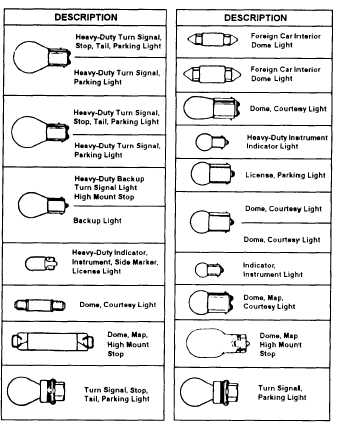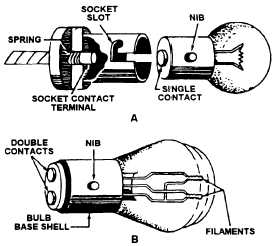good rule of thumb to remember is, if a light is on a
vehicle, the light must work and be safe.
Lamps and Bulbs
Trucks and buses are lit up like Christmas trees
when operating at night. In addition to the headlights
and taillights, which are the minimum running lights
required bylaw for all vehicles operating at night, trucks
and buses must also have clearance and side marker
lights. These lights outline the length, height, and width
of the vehicle.
Each group of lights in a branch circuit of the
lighting system is protected by a fuse or circuit breaker
and is provided with a switch. Each light in the group
is provided with one or more light bulbs that are rated
for the particular circuit.
Light bulbs used in Navy equipment are made to
operate on a low-voltage current of 12 or 24 volts,
depending upon the voltage of the battery system used.
Bulbs are rated as to size by the candlepower of light
they produce. They range from small one-half
candlepower to large 50-candlepower headlight bulbs.
The greater the candlepower of the bulb, the more
current it requires when lighted. Bulbs are identified by
a number on the base.
Operators are responsible for replacing burned-out
bulbs on equipment.
Manufacturers have designed
bulbs with such a wide variety of designs (fig. 4-4) that
it is impossible to list all the bulbs here. A bulb design
commonly used has either single or double contacts with
nibs to fit bayonet sockets, as shown in figure 4-5.
Because of some unique designs, certain bulbs have to
be handled with care; for example, quartz bulbs should
not be touched by the oil in your skin, because the oil
causes the bulb to fail instantly. Because of the unique
characteristics of the various bulbs, you should check
the operator’s manual before replacing any bulbs.
The sealed beam light is actually a large bulb (fig.
4-6). The bulb consists of a lens, filaments, and a glass
reflects. Sealed bulbs also have various designs; some
have filaments designed for high beam, some with one
filament designed for low beam, and bulbs with two
filaments designed for high and low beam.
Clearance Lights
Clearance lights detail the maximum width of the
vehicle, not necessarily its height as the word clearance
implies. These lights highlight the protruding unlighted
front and rear corners of the vehicle that are subject to
Figure 4-4.—Bulbs.
Figure 4-5.—Single- and double-contact bulbs.
collision with other vehicles or persons, not the top of
the vehicle. Clearance lights should be mounted at a
height best suited to allow them to be readily seen from
a minimum distance of 500 feet from the vehicle. The
clearance light on the front of a vehicle should be amber
in color, and those facing the rear red. Some state
regulations require that larger vehicles have identification
4-4



